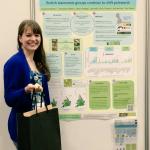Recording scheme data feeds in to prize-winning research
Data from the Soldierflies and Allies Recording Scheme, along with data from many other recording schemes, has recently featured in two prize-winning conference posters.
At the end of 2015, Charlie Outhwaite and colleagues (Gary Powney, Tom August and Nick Isaac) presented a poster at the British Ecological Society conference: "Monitoring the UK's less well-studied species using biological records". This looked at how to assess trends in species for which there are relatively few records (compared to groups like birds and butterflies). Soldierflies and allies were one of the groups included, among a range of others. Of the 7,493 species modelled, data was not sufficient to produce a reliable result in almost 80% of cases. Where data could be modelled well, it showed an overall decline of 15% across all species groups. Analaysis for the soldierfly group show that over half of the 28 species assessed are declining, and less than a quarter are increasing. This poster was runner-up as 'Best Poster' at the conference - for more details and to download a copy of the poster go to the CEH blog.
And on the other side of the world, Suzanna Mason and colleagues (Georgina Palmer, Simon Gillings, Jane Hill, Chris Thomas, Richard Fox, and Tom Oliver) presented a poster in Tasmania, at the "Species on the Move" conference in February: "Geographical range margins of a wide range of British taxonomic groups continue to shift polewards". This also analysed a wide range of 21 different invertebrate groups, including soldierflies, to look for evidence of range change, and to see if the amount of change varied between groups. For the vast majority (but not all) of the groups analysed there is a clear trend for ranges to move northwards in the UK, but the amount of change does vary between groups. In the case of soldierflies and allies the data does not show as substantial a change as in groups such as caddisflies and aquatic bugs, for instance. This poster won an award as 'Outstanding Student Poster' at the conference. The poster itself can be downloaded here, and a related research paper is freely available as part of the BRC 50th anniversary issue of the Biological Journal of the Linnaean Society.
Thanks to all who send in records to recording schemes, and it's great that the data can be used by researchers to help track what is happening to our species.
- Martin Harvey's blog
- Log in to post comments

